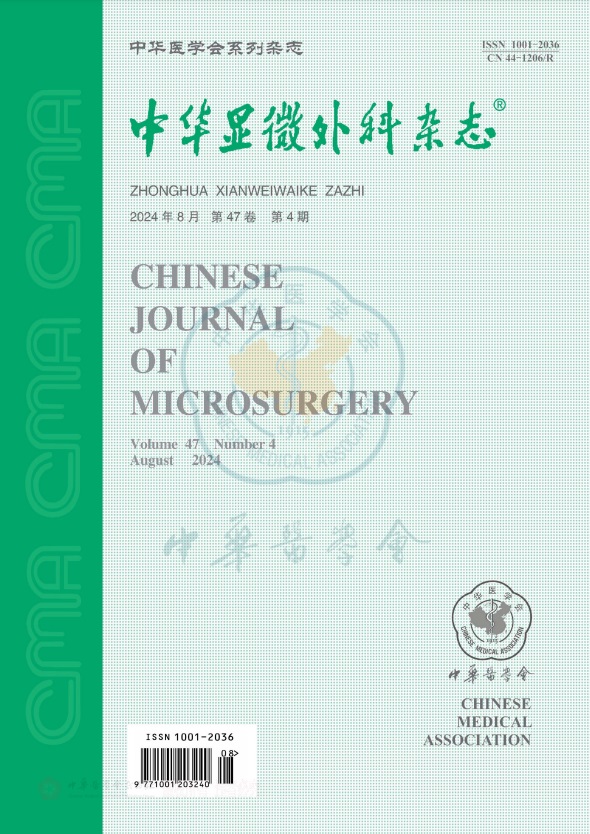Clinical application of 3 types of the medial shank island flaps
引用次数: 0
Abstract
Objective To compare the application and results in repairing wounds on shank and medial malleolus by perforator pedicled middle and lower third of posterior tibial flap, saphenous neurovascular flap and posterior tibial artery perforator plus saphenous neurovascular (double blood supply) flap. Methods Clinical data of 60 patients with wounds on shank and medial malleolus and treated between August, 2015 and December, 2018 were analyzed. Among the patients, 25 were treated with perforator pedicled middle and lower third of posterior tibial flaps, 15 with saphenous neurovascular flaps, and 20 with double blood supply flaps. The data of surgery, survival of the flaps, texture and swelling of the flaps, patient satisfaction and scores set by American Orthopaedic Foot and Ankle Society(AOFAS) were collected. Statistic analysis was carried out to compare observations among the 3 groups. Results Postoperative followed-up was 6 to 24(average 13.4) months. One flap suffered insufficient blood supply in the group of perforator pedicled middle and lower third of posterior tibial flaps, 2 flaps suffersd necrosis and skin graft was carried out in reverse saphenous nerve neurocutaneous flaps group. In double blood supply flaps group, 2 flaps appeared purple after surgery, and improved after removing the pedicle sutuer, and flaps became swelling and received secondary repair. All AOFAS scores (93.8, 93.3 and 92.8, respectively) and patient satisfaction were high in all 3 groups. Conclusion All 3 types of flap are able to be used in repairing the soft tissue defect on shank and medial malleolus. The inclusive of saphenous nerve should be determined in intraoperation according to the presence and size of the perforator. If artery perforation is reliable, the use of posterior tibial artery perforator flap in wound repairing will deliver satisfactory outcomes in terms of blood supply and appearance of the flap. For the wider area of wound, a flap with double blood supply is preferred. Key words: Shank; Posterior tibial artery perforator flap; Saphenous neurovascular flap; Repair; Microsurgical technique3种小腿内侧岛状皮瓣的临床应用
目的比较带胫后中下三分之一穿支皮瓣、隐神经血管皮瓣和胫后动脉穿支加隐神经血管(双血供)皮瓣在小腿内踝创伤修复中的应用及效果。方法分析2015年8月至2018年12月收治的60例小腿内踝创伤患者的临床资料。其中25例采用带穿支蒂胫后中下三分之一皮瓣,15例采用隐神经血管皮瓣,20例采用双血供皮瓣。收集手术数据、皮瓣的存活率、皮瓣的质地和肿胀、患者满意度和美国足踝骨科学会(AOFAS)评分。对3组患者的观察结果进行统计分析比较。结果术后随访6~24个月,平均13.4个月。胫后中下三分之一带穿支蒂皮瓣组1例血供不足,2例坏死,逆行隐神经营养皮瓣组行皮片移植。双血供皮瓣组,术后2个皮瓣出现紫色,取蒂缝合后改善,皮瓣肿胀,二次修复。所有三组的AOFAS评分(分别为93.8、93.3和92.8)和患者满意度均较高。结论3种皮瓣均可用于修复小腿及内踝软组织缺损。隐神经的包容性应在术中根据穿支的存在和大小来确定。如果动脉穿孔是可靠的,那么在伤口修复中使用胫后动脉穿孔皮瓣将在血液供应和皮瓣外观方面产生令人满意的结果。对于较宽的伤口区域,首选双血供皮瓣。关键词:香客;胫后动脉穿支皮瓣;Saphenous神经血管皮瓣;修理;显微外科技术
本文章由计算机程序翻译,如有差异,请以英文原文为准。
求助全文
约1分钟内获得全文
求助全文
来源期刊
CiteScore
0.50
自引率
0.00%
发文量
6448
期刊介绍:
Chinese Journal of Microsurgery was established in 1978, the predecessor of which is Microsurgery. Chinese Journal of Microsurgery is now indexed by WPRIM, CNKI, Wanfang Data, CSCD, etc. The impact factor of the journal is 1.731 in 2017, ranking the third among all journal of comprehensive surgery.
The journal covers clinical and basic studies in field of microsurgery. Articles with clinical interest and implications will be given preference.

 求助内容:
求助内容: 应助结果提醒方式:
应助结果提醒方式:


